The piece of the month of July 2021
SATIRICAL DECK OF CARDS OF THE 1868 REVOLUTION IN A NAVARRESE COLLECTION
Eduardo Morales Solchaga
Chairof Navarrese Heritage and Art
Few periods in Spain's contemporary history are as convulsive and politically rich as the Democratic Sexenio (1868-1874). In just six years we witnessed a revolution, "La Gloriosa", which put an end to the reviled reign of Isabel II and her "Court of Miracles"; the arrival of a foreign king, Amadeo I of Savoy, who years later would put his feet on the ground when faced with the impossibility of controlling an ungovernable country; and the first - and failed - republican experience since the time of the Visigoths. The end of the period, marked by extremism, was set by a new pronunciamiento by means of which Martínez Campos raised Isabella II's son, Alfonso XII, to power, thus beginning the period known as the Bourbon Restoration, and truncating the sweet political transition projectthat had been meticulously planned by Cánovas del Castillo.
Throughout the Sexenio, the economic crisis, one of the triggers of the Revolution, never left the country, and was aggravated by anarchist uprisings in the Levant, the phenomenon of cantonalism, the last of the Carlist wars, and a long colonial war in Cuba, the "Pearl of the Antilles". The only light in the financial field was the unification of the currency through the minting of the peseta, which occupied a home in the wallets - and hearts - of Spaniards until the dawn of the 21st century.
However, these six years were not all shadows, as democratic ideals were enshrined in the Constitution of 1869, which provided for hitherto inconceivable aspects such as universal male suffrage, national sovereignty, freedom of association, freedom of teachingand freedom of the press. It was precisely the end of censorship that made possible a frenzy of production and publishing house, hitherto reserved for the underground, with the scandalous album on the court of Isabella II(Los Borbones en pelota), which could not see the light of day even in this era of undeniable freedom, being particularly noteworthy. Among the numerous periodicals that appeared or were promoted during the Sexenio were some from Madrid, such as Jeremías and Gil Blas, and those from Barcelona, which were particularly caustic, such as La Flaca, La Madeja Política and La Campana de Gràcia. All of them provide excellent images for generalist books and programs of studymonographs on the period.
The piece of the month presented here combines satire and entertainment, and was advertised in the above-mentioned Campana de Gràcia on 25 September 1870 (Figures 1 and 2), describing its characters, quality, price and possible authorship. It saw the light of day in the same house publishing houseas the weekly in question, run by the famous publisherInocencio López Bernagossi (1829-1895), who had taken an active part in the revolution itself. There were two types, one of lower quality for four reales, and another, with finer lithographs, which was sold at double the price. Perhaps they correspond to the different versions known: one, with a fuchsia marbling on the reverse; the other two, with the same patron saint, but in blue and red.
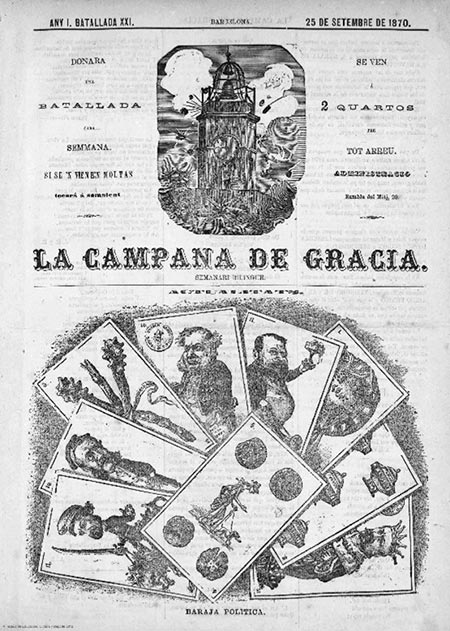
Front cover of La Campana de Gràcia, 25 September 1870.
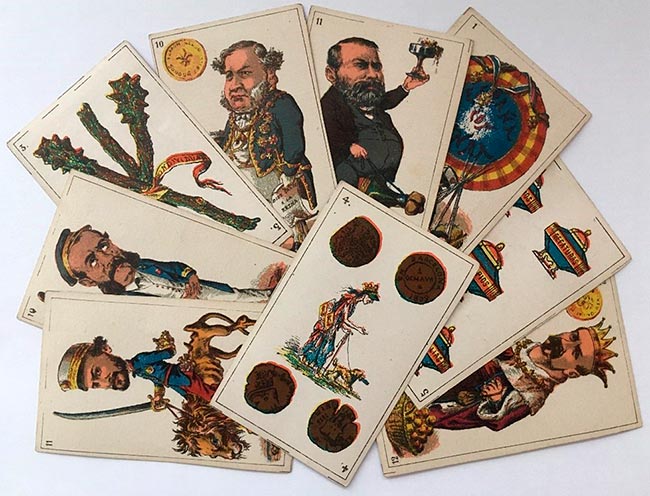
Figure 2. Recreation of the cover, with the cards of the deck.
The deck of cards, of which, apart from the one presented here, only two complete copies remain - the Fournier de Naipes Museum in Vitoria and fileHistórico de la Ciudad de Barcelona - and another two partially complete ones - one in the same filein Barcelona, which is missing the ace of spades, and another in the Museo del Romanticismo in Madrid which has lost the ace of golds), was reissued in its version with the blue reverse by Fournier in 1999, although erroneously associated with the Barcelona lithograph of Francar y Compañía, and with errors in the identification of the characters and chronology (1872). A recent in-depth study at positionby Carmen Linés Viñuales has attributed it to the presses of López Bernagossi and has adjusted its chronology to September 1870, just two years after "La Gloriosa". Another reprint of 500 copies was printed in Valencia for the XXX Feria del Libro (2007), financed by the booksellers' guild of that city.
Regarding the author of the compositions, according to the publication "one of the first Spanish caricaturists", the same researcher points to the famous Barcelona cartoonist Tomás Padró (1840-1877), although without completely discarding the prestigious Madrid author Francisco Ortego (1833-1881), hypothesis for which the Catalog the Historical file of the City of Barcelona opts. If it was the former, he would have composed it weeks before leaving to document the arrival of Amadeo I of Savoy; if it was Ortego, months before leaving for Paris in search of prestige and evaluation. Be that as it may, the compositions are agile and ingenious, demonstrating a perfect knowledge of the political panorama not only of the Sexenio, but of the entire second half of the 19th century.
The Spanish deck, of 48 cards, is in exceptional condition and uncirculated, although it does not - like all existing examples - preserve the box, if it ever had one. As mentioned above, it is the version with the fuchsia finish on the back (Figure 3), like those preserved at the fileHistórico de la Ciudad de Barcelona. It has the same suits (golds, swords, clubs and cups) as the traditional decks, although with satirical iconography, perfectly identified by the aforementioned Carmen Linés, following the clues in the Barcelona publication.
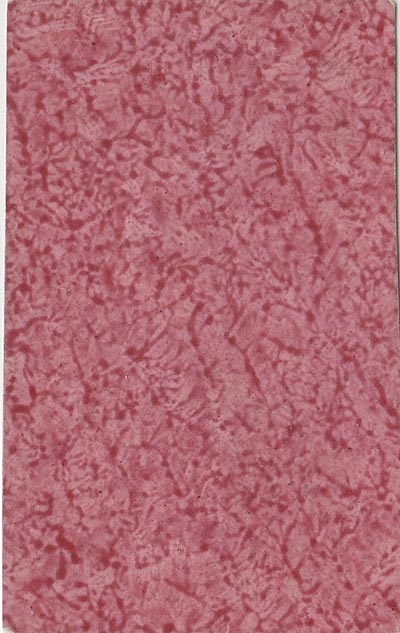
Figure 3. Reverse side of the letters.
With regard to the golds (Figure 4), except for the figures, they are made up of deteriorated coins of little value, making reference letterto the statusof the nation's continuous crisis, which even appears, starving, begging for alms in the form of an allegory in the four of golds (Figure 5).

Figure 4. Palo de oros.
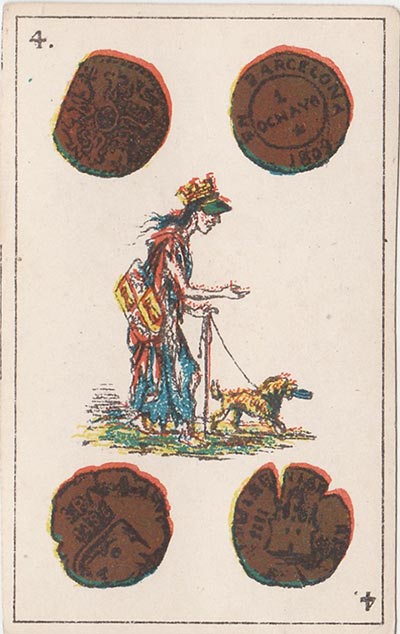
Figure 5. Four of gold.
As for the figures, the ace sampledepicts a military man gagging an allegory of freedom in the form of a young matron, with a cockade in the background bearing the slogan of the 1868 Revolution "Long live Spain with honour" (Figure 6); the jack is represented by Salustiano Olózaga (1805-1873), once a supporter of Isabel II and at the time president of the progressive party and ambassador to Paris, as he is depicted (Figure 7).
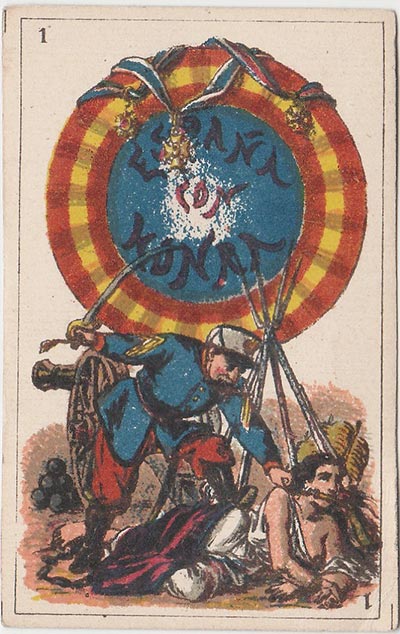
Figure 6. Ace of golds.
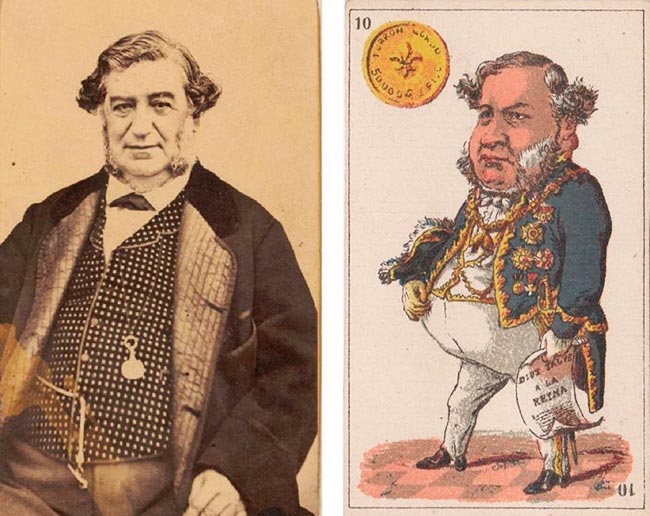
Figure 7. Salustiano Olózaga.
The horse, in this case a colt, is the Minister of Finance Laureano Figuerola (1816-1903) playing some timpani, who took advantage of the Sexenio to modernise the country's Economics, putting an end to protectionism and opting for a single currency (Figure 8).
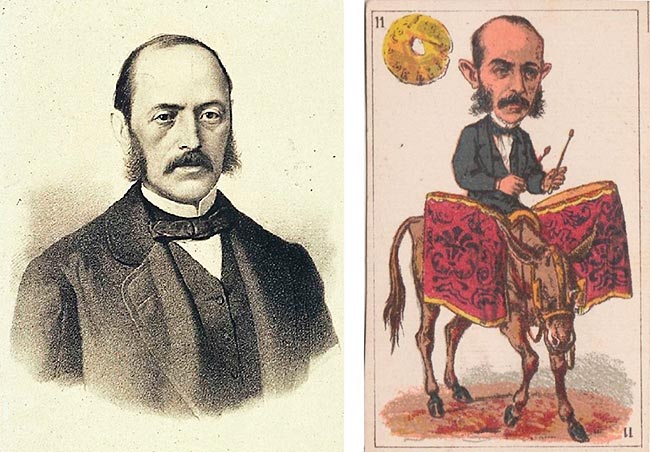
Figure 8. Laureano Figuerola.
Finally, the King of Gold is the Duke of Montpensier (1824-1890), a pretender to the throne who fell into disgrace after a duel with the Duke of Seville, and who probably financed the assassination of Prim. reference letterHe appears dressed as a bandit, but concealed by the royal mantle and insignia, and with a basket of oranges at his feet, in reference to his nickname of "orange king", in reference to the citrus crops he cultivated on his lands in Seville (Figure 9).
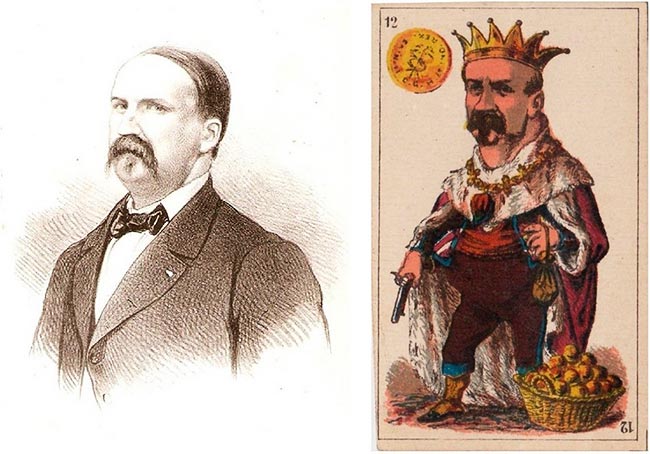
Figure 9. Duke of Montpensier.
The palo de espadas (Figure 10) represents military influence in Spanish politics, regardless of the theoretically democratic change that had taken place.

Figure 10. Palo de espadas.
The ace symbolises the breaking of the pitcher of universal suffrage, pressed by the sword of the law, surrounded by artillery elements and crowned by the sentence "state of siege" (Figure 11).
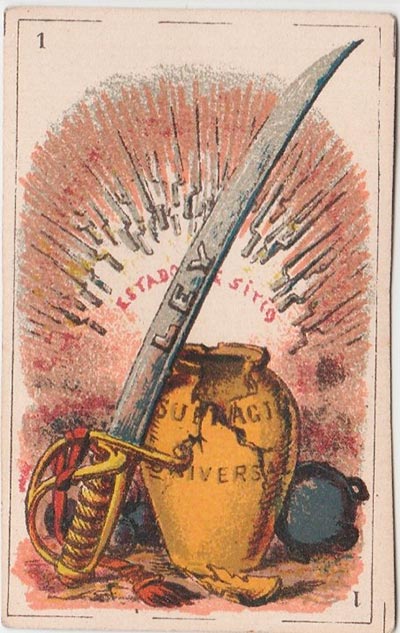
Figure 11. Ace of spades.
The jack is Pascual Madoz (1806-1870), former Minister of Finance during the Progressive Biennium, who, dressed as a military man, carries a banner with the colours of the flag on which is written "Long live Grandfather", as he was a strong supporter of the candidacy of Espartero, who had elevated him to the rank of Minister in his day (Figure 12).

Figure 12. Pascual Madoz.
The horse is Juan Prim (1814-1870) on a famished lion representing the nation. Figures of kinglets appear from his pocket and he hides the crown on his back, in relation to his occultist attitude before the Cortes (Figure 13).
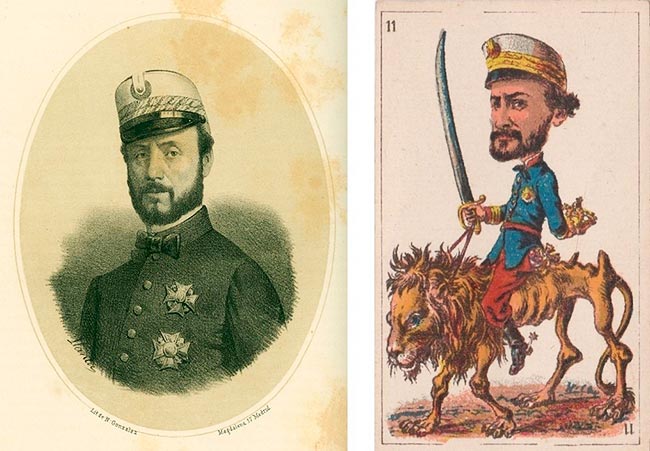
Figure 13. Juan Prim.
Finally, the king of swords symbolizes the unknown monarchy, in the form of an "X" on the throne, on which the symbols of the Spanish monarchy are displayed (Figure 14).
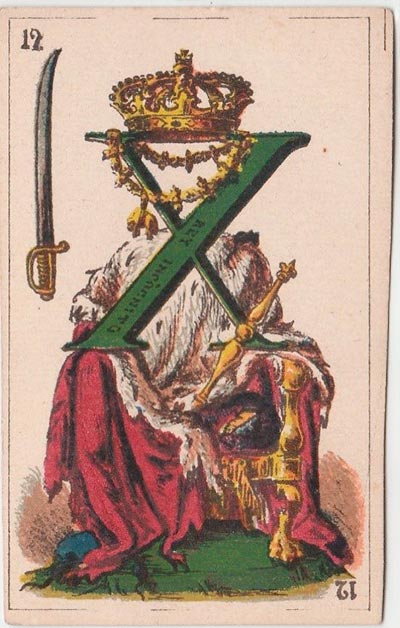
Figure 14. The unknown monarchy.
The de bastos (Figure 15) makes reference letter, according to Linés Viñuales, "La partida de la porra", armed groups financed by the government that attacked and threatened sectors of the civil service examination.
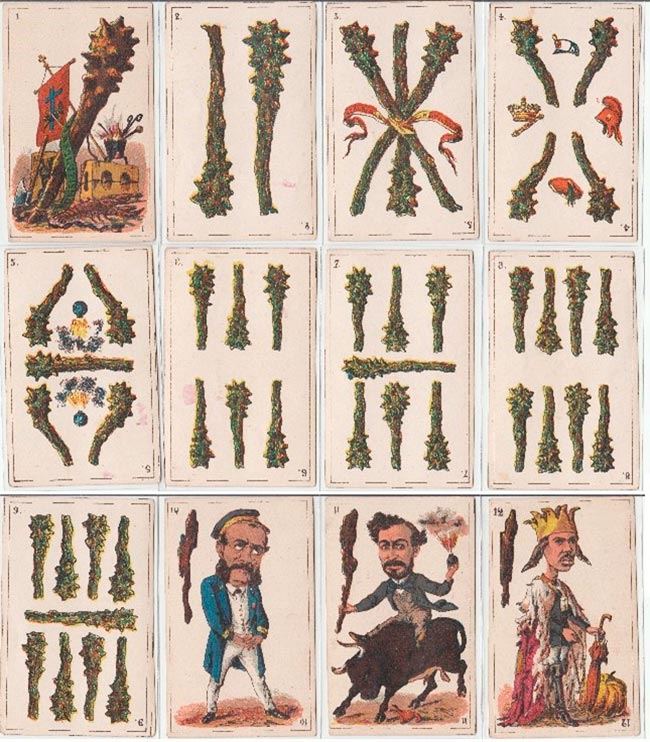
Figure 15. Club of clubs.
The ace symbolises the Ancien Régime and is adorned with the legend "Absolutism", a banner of the Inquisition and instruments of torture. In its lower right part is a crab symbolising regression (Figure 16).
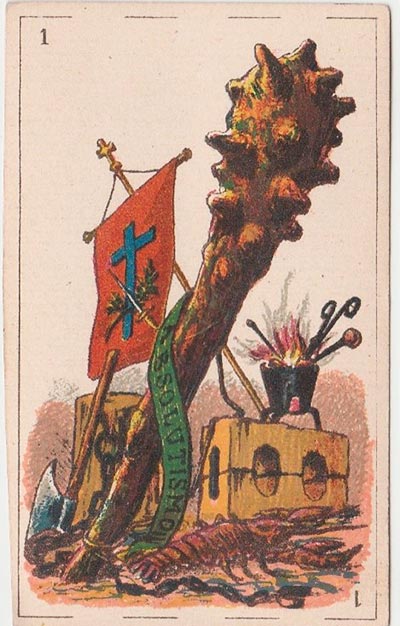
Figure 16. Ace of clubs.
In the four of clubs the symbols of the main agents of the Sexenio: military, republicans, Carlists and monarchists (Figure 17).
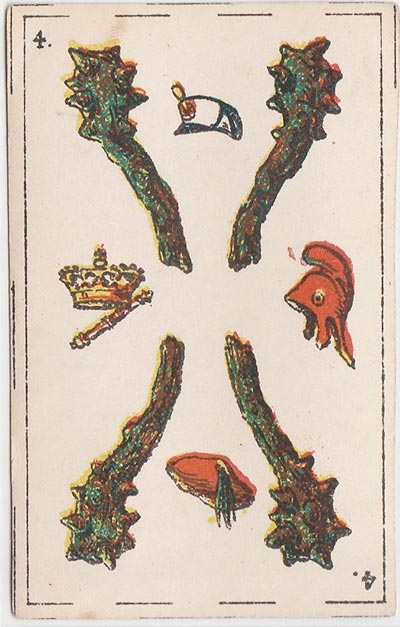
Figure 17. Four of clubs.
The jack represents Juan Bautista Topete (1821-1885), one of the main architects of the revolution, who resigned after the election of Amadeo of Savoy as king, as he defended the candidacy of the Duke of Montpensier. He is depicted dressed as an admiral and with a melancholy look in his eyes (fig. 18).
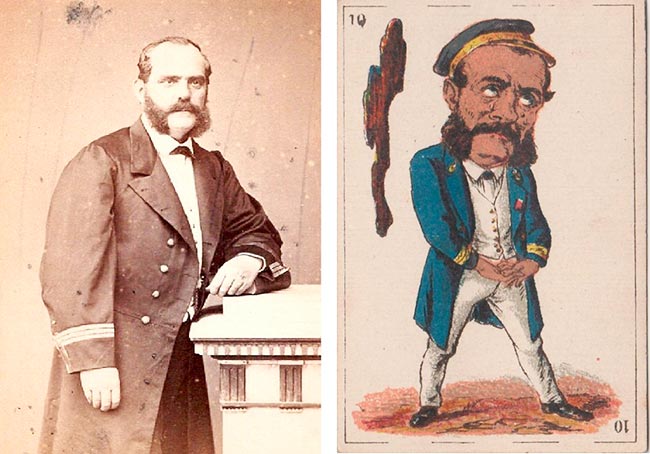
Figure 18. Juan Bautista Topete.
The horse represents Práxedes Mateo Sagasta (1825-1903), Minister of the Interior, who had to face the great instability resulting from the failure to fulfil the promises of the revolution, materialised in the form of a raging bull. Below him, the trampled Phrygian cap symbolises republican aspirations (Figure 19).
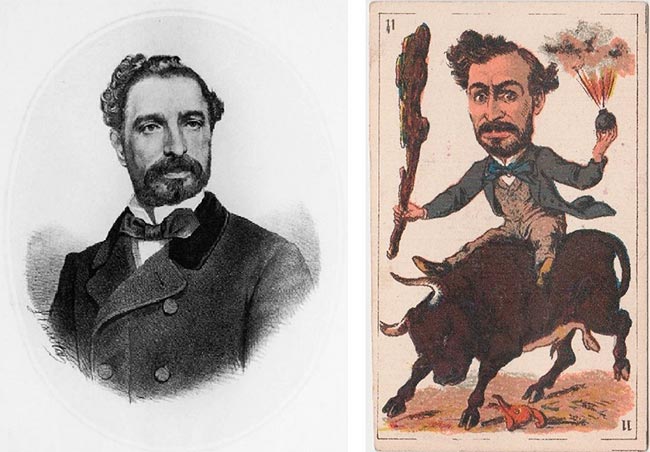
Figure 19. Práxedes Mateo Sagasta.
Finally, the King of clubs is the pretender Charles VII (1848-1909) in his most decrepit version, wearing a scapular, rosary and donkey's ears under an expired crown. He holds a parasol as a baton, and at his feet is a huge pumpkin symbolising the end of his idyll with the Spanish crown. Two years later the last of the Carlist Wars would begin (Figure 20).
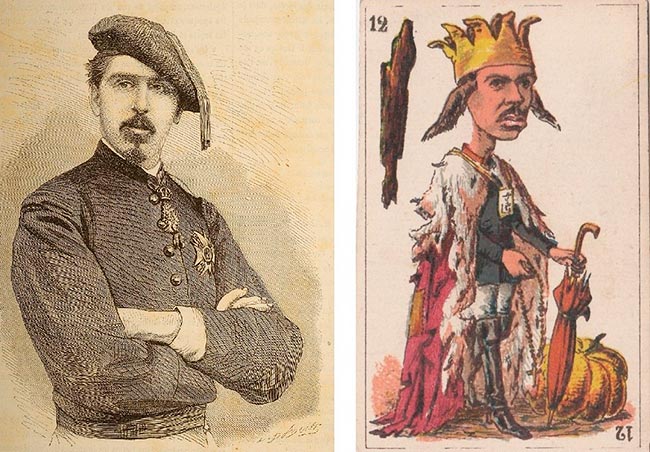
Figure 20. Don Carlos.
Lastly, the cup stick (Figure 21) depicts small soup tureens in which the perks and privileges that were shared out by the protagonists of the upstart regime are depicted.
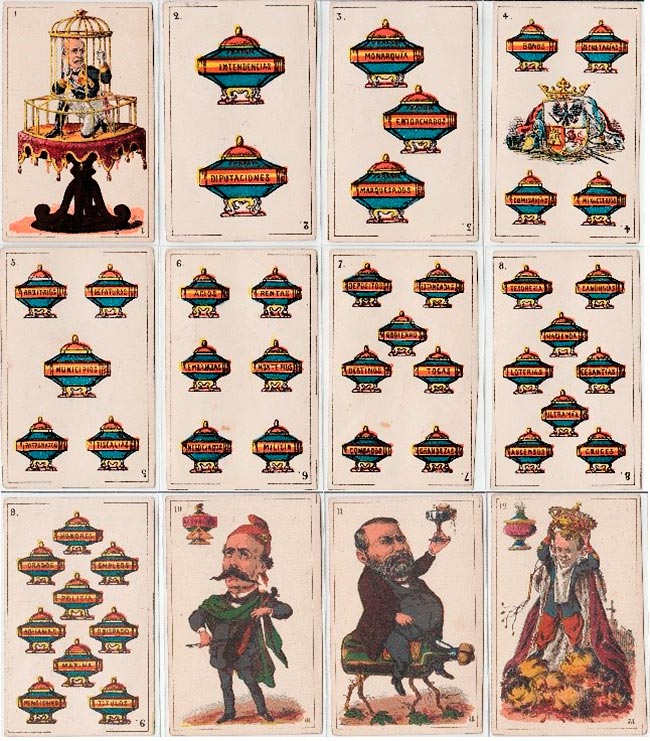
Figure 21. Palo de copas.
Among them is the four of cups, featuring a coat of arms with the arms of Castile and the imperial eagle, surrounded by military harnesses totally decomposed in reference letterto the nation's outdated imperial vocation (Figure 22).
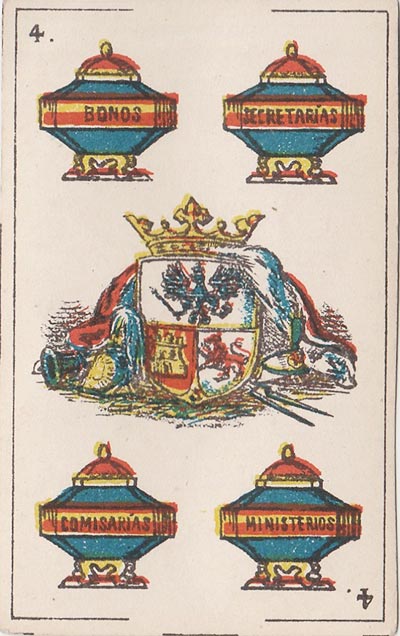
Figure 22. Four of cups.
As for the figures, the ace represents the regent Francisco Serrano (1810-1885), protagonist of "la Septembrina" together with the aforementioned Prim and Topete, in the golden cage that his regency entailed, who left power in the presidency (Figure 23).
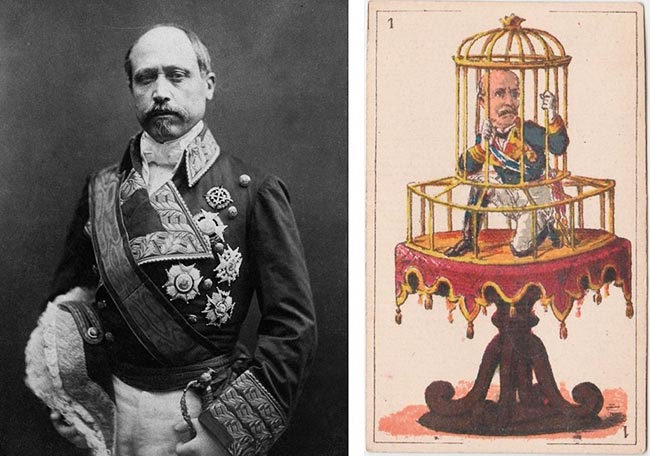
Figure 23. Francisco Serrano.
The jack is represented by Emilio Castelar (1832-1899), wearing a Phrygian cap and melancholically playing a violin in a party -of the monarchy- that was not his own. Years later he became president of the republic, following his unitary and conservative ideals (Figure 24).
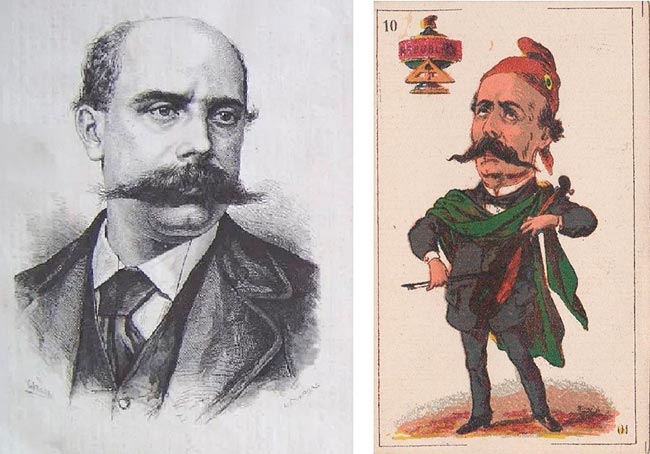
Figure 24. Emilio Castelar.
The horse is Nicolás María Rivero (1814-1878), who successively held the post of mayor of Madrid, the presidency of congressand the Ministry of the Interior during the Sexenio. He belonged to the Federal Democratic Republican Party, which ended up supporting the constitutional monarchy and betraying its ideals, and was therefore the object of copious criticism from the republican sphere and its publications reference letter, such as the aforementioned Campana de Gràcia. A bottle of wine, walking on vines, and toasting with a glass in allusion to his supposed fondness for morapio (Fig. 25).
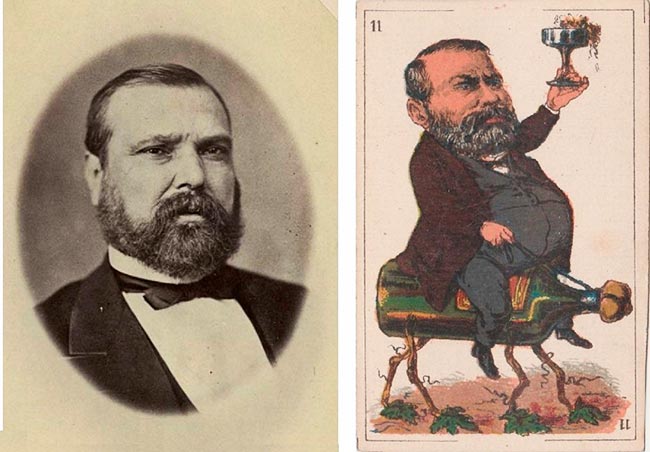
Figure 25. Nicolás María Rivero.
Finally, the King of Cups presents the future Alfonso XII (1857-1885), standing on a mountain of decapitated heads and with a gallows behind him. He carries a riding crop, bib and royal attributes, crowning himself in the Napoleonic manner. The emblem on the pole bears the word "derechos" (rights), alluding to the fact that Isabella II had ceded her dynastic rights to him that same year (Figure 26).

Figure 26. Alfonso XII.
As far as the origin of the deck of cards preserved in the Navarre collection is concerned, it comes from the estate of Antero Irazoqui y Echenique (1849-1919) (Figure 27) and has been preserved in a small box of cards from visitbelonging to him and dating from 1896. Born in Vera de Bidasoa, he always enjoyed a comfortable economic situation status, as he became the heir of his father, Pablo Esteban de Irazoqui, a wealthy merchant who was well connected with Bayonne and Madrid. trainingThis probably made it possible for him to go to Paris, where he met his close friend Pablo Sarasate. This trainingcrystallised in his appointment as supernumerary administrator of the branch of the Banco de España in Pamplona. A member of the Liberal Conservative Party and a good friend of Eduardo Dato, he was a member of Parliament for the Pamplona constituency, senator for Navarre and civil governor of Lérida, Gerona and Ciudad Real. A founding member of the associationSanta Cecilia (1879), he held other cultural posts of interest, such as the presidency of the Casino Principal de Pamplona (1910) and the Bursar's Officeof the associationEuskara de Navarra (1878), an institution that he left along with other liberals, as they disliked the nationalist direction it had taken. A man of strong religious convictions, he was very much appreciated in his native town, where he went in his last years, and in whose cemetery he is buried.
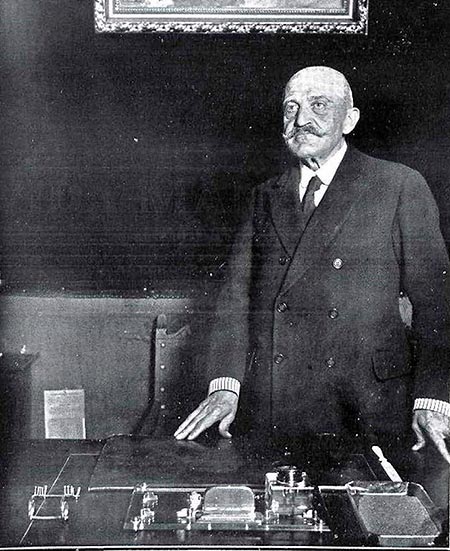
Figure 27. Antero de Irazoqui in the Civil Government of Ciudad Real.
The following words from a publication of the time attest to its political dimension:
In politics today, unfortunately, there are few men who can be justly praised, but among the most worthy we must consider Don Antero de Irazoqui, a most distinguished personality and politician of great prestige and deep-rootedness. He is a member of the conservative party, of which he is a great element and where he is much loved and appreciated for his outstanding qualities, his talents and his civic virtues. In Navarre he is very popular and loved by all the people, and enjoys a good social position. The interests of the people of Navarre have in Mr. Irazoqui their most enthusiastic defender and worthy representative [...]. Mr. Antero de Irazoqui is a man of vast enlightenment, a noble and pundonorous gentleman, of unusual honesty, active and hard-working, and for his unquestionable merits he is justly deserving of public esteem and general appreciation.
It is not surprising that a political personality of such calibre acquired and incorporated for his cabinet of curiosities the deck of cards in which, as we have seen, some of his contemporaries were caricatured, and which is exhibited here as the piece of the month.
SOURCES AND BIBLIOGRAPHY
Catalog Online of the Fournier Playing Card Museum of Alava, inventory number: 44527. La Campana de Gracia, no. 21 (1870).
BOZAL, V., La ilustración gráfica del siglo XIX en España, Madrid, Comunicación, 1979.
CHECA GODOY, A., El ejercicio de la libertad: La prensa española en el Sexenio Revolucionario, Madrid, Library ServicesNueva, 2006.
FONTANALS I DEL CASTILLO, J., Recuerdo al artista Tomás Padró: tribútanle otros de los admiradores de su ingenio, Barcelona, Imprenta de Celestino Verdaguer, 1877.
LINÉS VIÑALES, C., Baraja de la Revolución, Madrid, Museo del Romanticismo, 2018.
OROBON, M. A., "Humor gráfico y democracia: algunas calas en la caricatura política en el Sexenio Democrático", in Humor y política en el mundo hispánico contemporáneo, Paris, Université Paris X, 2006, pp. 9-20.
S/A., "Don Antero de Irazoqui", in España parlamentaria (congress): Semblanzas de los señores que componen las señores que compen las Cortes elegidas el 19 de mayo de 1901, Madrid, Imprenta de Guzmán el Bueno, 1901, pp. 261-262.
SARRÀ, E. and SÁNCHEZ, P., Catàleg de la col-lecció de naips de l'Arxiu Històric de la Ciutat de Barcelona (1529-1988), Barcelona, Barcelona City Council, 2018, pp. 219-220.
